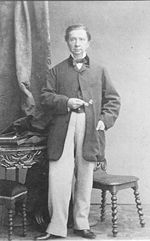
Janus Henricus Donker Curtius
Encyclopedia

Arnhem
Arnhem is a city and municipality, situated in the eastern part of the Netherlands. It is the capital of the province of Gelderland and located near the river Nederrijn as well as near the St. Jansbeek, which was the source of the city's development. Arnhem has 146,095 residents as one of the...
– 27 November 1879, Arnhem http://stamboom-boden.com/getperson.php?personID=I1083956907&tree=1) was the last Dutch commissioner for the island of Dejima
Dejima
was a small fan-shaped artificial island built in the bay of Nagasaki in 1634. This island, which was formed by digging a canal through a small peninsula, remained as the single place of direct trade and exchange between Japan and the outside world during the Edo period. Dejima was built to...
in Japan. He studied law at Leiden University
Leiden University
Leiden University , located in the city of Leiden, is the oldest university in the Netherlands. The university was founded in 1575 by William, Prince of Orange, leader of the Dutch Revolt in the Eighty Years' War. The royal Dutch House of Orange-Nassau and Leiden University still have a close...
.
He arrived in Dejima in 1852, and was contemporary with the forcible opening of Japan by Commodore Matthew Perry
Matthew Perry (naval officer)
Matthew Calbraith Perry was the Commodore of the U.S. Navy and served commanding a number of US naval ships. He served several wars, most notably in the Mexican-American War and the War of 1812. He played a leading role in the opening of Japan to the West with the Convention of Kanagawa in 1854...
in 1853. He was able to assist others, including Western diplomats, in the process of adjusting and working through unfamiliar Japanese customs and practices.

Kanko Maru
The was Japan's first steam warship. The ship was a 3-masted top sail schooner , with an auxiliary coal-fired steam engine turning a side paddlewheel...
and became the nation's first step in establishing a modern navy.
He established a format treaty between the Netherlands and Japan in 1856, and, in 1858 was the last Dutch chief ("opperhoofd") to make the ceremonial visit to Edo
Edo
, also romanized as Yedo or Yeddo, is the former name of the Japanese capital Tokyo, and was the seat of power for the Tokugawa shogunate which ruled Japan from 1603 to 1868...
to pay tribute to the Shogun
Shogun
A was one of the hereditary military dictators of Japan from 1192 to 1867. In this period, the shoguns, or their shikken regents , were the de facto rulers of Japan though they were nominally appointed by the emperor...
. During that last trip, he acquired a collection of 111 books on Rangaku
Rangaku
Rangaku is a body of knowledge developed by Japan through its contacts with the Dutch enclave of Dejima, which allowed Japan to keep abreast of Western technology and medicine in the period when the country was closed to foreigners, 1641–1853, because of the Tokugawa shogunate’s policy of national...
, which are today preserved at Leiden University
Leiden University
Leiden University , located in the city of Leiden, is the oldest university in the Netherlands. The university was founded in 1575 by William, Prince of Orange, leader of the Dutch Revolt in the Eighty Years' War. The royal Dutch House of Orange-Nassau and Leiden University still have a close...
Library.

